Now I must admit, planning didn't start well - and I always plan. I had 10 days planned with my family in Hong Kong, and I punched in the place on my iPad for my Weather channel to provide me with a day by day assessment. So imagine my astonishment when I read a range of 7 to 16 Centigrade (44-57 Fahrenheit). It is supposed to be tropical, typhoons, yes, mist and fog, lots of rain, sure, but abject cold? I'd have to pack jumpers, gloves; what rigmarole!

Looking toward Repulse Bay
I moped a bit that day; perhaps it did get cold. My last visit was in late 1980's. I recalled, "hot and sweaty," with the ice fields in the air-conditioned hotels. So like us all, I "Googled it." No, a pleasant 20-24 centigrade. Back to the bloody weather channel to reset. And there it was again, freezing temperature ... but then I looked closely, and the default for Hong Kong had taken me to CANADA. Well wag the dog! Default maybe, but the fault mine. Read fine print, Dumbo. Jumpers outta suitcase faster than butter melts in the frying pan
The last time I flew to Hong Kong, it had been to the old Kai Tak airport. With my parliamentary boss, I had once been in the QANTAS flight simulator while a pilot tested. He gave an audible groan when the Check Captain said flippantly, "Okay, let's go to Hong Kong." You know, fly a 747 directly at a mountain till you lined up two markers to make a low level right turn to the approach glide path, then fly down a virtual "urban street," mountains on the left, tall buildings on the right. At eye level, you looked in on Mr Ong the tailor, Mrs Cheung in her kitchen. Throw in a good cross-wind, and an engine failure, as our Check Captain did, and it was "stuff on the pants" flying. Scary for pilots, who knew what they were doing, and for first time visitors, who didn't, thinking they were actually landing on the street! No wonder "our pilot" had a sweated brow, probably cursing the parliamentary visitor and the grand-standing Check Captain!
Well, it is not like that anymore. Hong Kong needed a new airport, as befits a key Asian hub, so they simply reclaimed the land between two islands (there are over 200 in the gathering that is "Hong Kong," so presumably two weren't missed), levelled much of one, reclaimed other bits of the sea, putting down two requisite and befitting runways (3800 metres,12,300 feet), and Hong Bob's your uncle! Built it all in record time (6 years), brushing aside some protests, political and ecological concerns, to have it handed over to the Chinese Government, one year after the ceremonial transfer of Hong Kong by the British (the airport got a year's "British" extension), in 1997. The $US20 billion airport was handed over and opened in 1998, suffering major teething troubles, which took over six months to sort out. Now it works - perfectly. Already it needs a third runway, reclamation is at full speed.
After nine and a half hours in a plane from Sydney, Australia, I uncoiled with all the élan of snail emerging from its home. A Jumbo with every seat taken and me at the back, a centipede ahead of me when the doors opened. Thank goodness for the many, long, moving footways, a chance to stretch those legs. An ultra modern terminal. Lots of entry booths, and all of them staffed, so while queues were long, they were zippy (pointers and direction marshals are omnipresent everywhere in Hong Kong!), bags already on the carousel, nothing to declare, out of the terminal in about 20 minutes; a breeze. And then, if necessary, a fast, clean and efficient train service to Kowloon, or a Central station on Hong Kong island, with excellent feeds to a modern Metro, London type Double Decker Red buses, iconic Double Decker French trams (Ding Dings, first introduced in 1904), or cheap as chips, metred taxis.

Ding Ding passes under one of Hong Kong's many elevated walkways
I was, most happily for me, met by my son, and we sped to "the island" by way of an excellent system of toll roads, under and overpasses, whisked through Kowloon, funnelled out of a tunnel into the Central District, where the traffic slowed, but flowed. Then up and up through the Middle Levels (past very tall buildings) to the Upper levels (filled by equally tall buildings) by a series of serpentine and switch back roads. Stunning Architecture and magnificent engineering. And beyond the roads on the Upper Level, a lush green fringe of rain forest, akin to nature's version of a pop star's Mohawk.
You notice immediately how clean and fresh everything looks; the total absence of litter, and the extraordinary design engineering to channel the flow of water from the Peak and elsewhere, militating against flooding. Drains are checked daily, streets swept fastidiously, no matter where they are. I was there during a wiper confronting "Amber" rain warning, where curtains of rain became drapes, and the flow from the Peak looked like the Angel Falls. Water, water everywhere, looking just to sink. When there is a Black Rain warning, often associated with typhoons, nobody moves. People are sent home, roads are deserted. It's a case of arrival, survival, revival.
Hong Kong is almost everywhere, growing daily and in the wonderful History Museum on Kowloon, there are maps showing the constantly changing shoreline as a result of dredging and land reclamation. There needs to be a "growth industry," because with two million on the Island alone, and a population density of 16,000 per square mile, more land must be created. So, for simply moving people, the solution for much of the pedestrian flow is over the street level, along concrete walkways, which interconnect almost everywhere in the Central area. For getting people up and down from the Mid and Upper levels, there is one of the world's longest escalators which brings people "down" to 10am, then switches to "up" for the rest of the working day. But irrespective of direction, gird your loins, massage your thighs, be prepared, for Hong Kong is steps, steps, and more steps. Or better still, save your energy for eating, sightseeing, exploring, and grab a taxi!
To walk in much of Hong Kong, you need to cultivate a "New York swivel neck," because given the immense cost of land, the focus, and profits, lie in maximizing occupancy. It is a case of up and up and up. And everywhere, like Meccano-like bamboo scaffolding, (think Lego but without the solidity) enough to make a safety unionist call everyone out on strike. With the constant rain, many work sites looked like dirty brown ponds, full of hard hats and waders. Sometimes the crane operator in his eyrie, high in the sky, disappeared in fog. What do those do when "nature calls?" All that construction now controlled from the ground by walkie talkie, long gone the days of the awesome steeple-jack, who rode the girders into the sky, as nonchalantly as any trapeze artist.
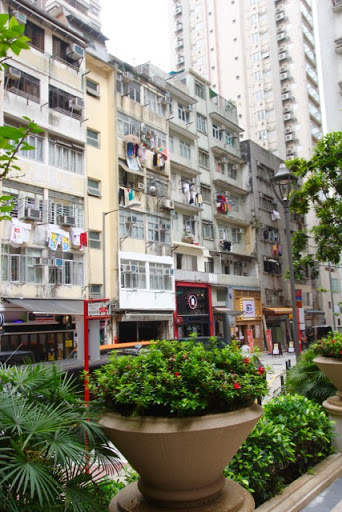
The old style accommodation amid the modern at Wan Chai
Small apartments in the poorer, older areas, with most airing their washing a-la-"true Asia," often over traditional market stalls selling every food, wet markets with fish and meat, other shops of teeming toys and toiletries, underpants and over shirts. I saw only bits of Wan Chai, but later, there were plenty of old style stalls and shops to see, on my effortless escalator assent towards Soho.
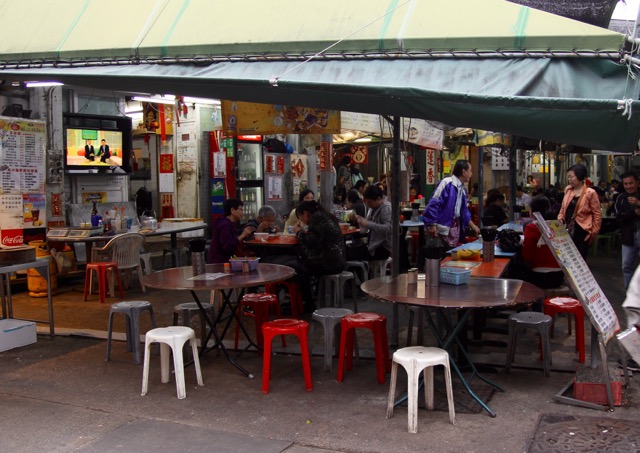
Street dining!
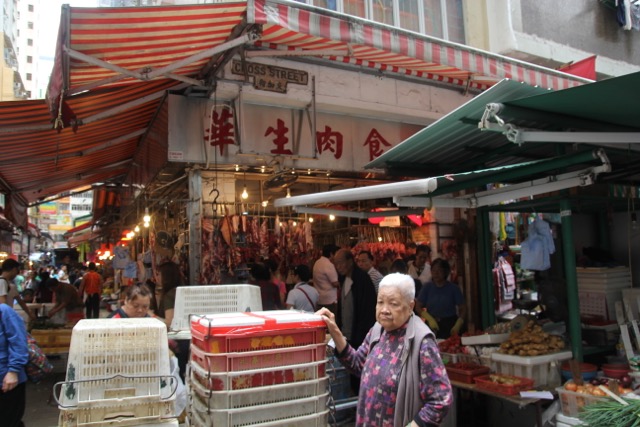
The old Wan Chai traditional market and food outlets
I think that what struck me most was the unexpected greenery of the island, land set aside for abundant park retreats and some quiet spaces for contemplation, less confusion, more Confucius. Plenty of glib sayings and advice to contemplate after a delectable Chinese meal, after the cookie crumbles. Lots of rain forest walks and leafy glens, for hiking and picnicking, although often packed to billy-o on weekend escape from the thrum.

Pools aplenty amid the High Rise of the Upper Levels as morning mist swirls.
The Botanical Gardens is a green area of tranquility, with traffic but a dull rumble. The screech of many exotic parrots, at a huge walk-in aviary, is a delightful musical accompaniment to communing with nature. Huge banyan trees, with large tentacle rib-like roots a kid's delight, and from their massive branches, vines that fall down like a pirate's dreadlocks. Lots of steps, quiet pathways, carp-filled lily ponds, the usual clean toilets, and outside the boundaries, a massive mall, swank hotels, and great coffee shops.
The other surprise was the ubiquitous display of wealth is the housing (the cost of a free standing house, apparently runs into tens of millions, much apartment rental in to tens of thousands) and more Lamborghinis, Ferarris, McLarens, Rollers, and Bentleys than you would see at the Dubai Cup. And in view of the limited number of roads, most as challenging as the Amalfi coast road, with no real highway to put your foot down without running up someone's clacker, you wonder why such extravagance on an island only 7 by 14 miles! Most, I was advised, are simply garaged and brought out only for special events worthy of showing up "in style."
Lots of grand and flashy apartment blocks with all sorts of amenities; enviable gyms, spas, infinity pools with an island vista, tennis and squash courts, steam room and sauna, oh and cubby hole maid’s quarters. Competent Filipinas and Indians to care for the kids and cook, oh, and walk the "poor drenched dogs," even when it is raining and a 'constitutional and crapping caper' is necessary. And when the sun is shining, there is inevitably a clutch of maids, with a cuddle of kids, at the attractive, tower-fringed Repulse Bay beach and at Stanley. Someone to watch over the kids while the expats patronize a cabal of ocean front coffee shops and peruse the paper. With commensurate "huge wages/allowances," to meet the high cost structure of living in Hong Kong, expat life is good.
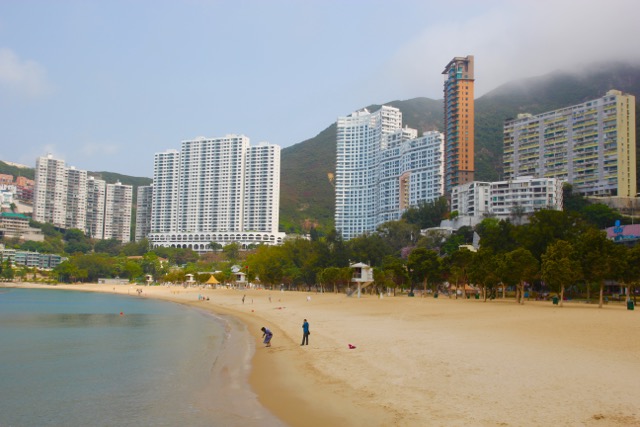
The Beach at Repulse Bay, Hong Kong Island
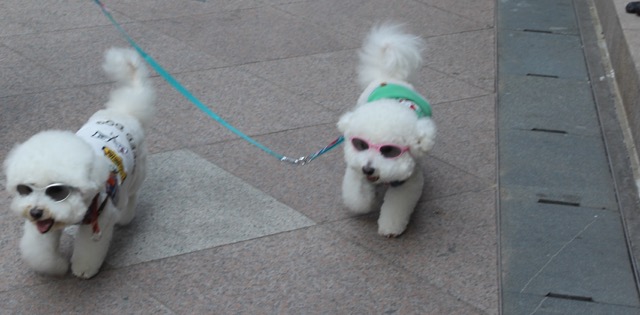
Pampered pooches out for a morning walk at Repulse Bay
There are plethora of "marbleous" malls, with their hectares of marble space, prestige shop-fronts, Valentino, Gucci, Van Clef and Arpels, Zegna, De Beers, etc, etc. There are five or six of these creations on the island and Kowloon, and the big names are evident in all. Tourists by the mega liner, true, but presumably there is abundant local custom as well. It says something about the salaries, wages, and allowances of many Hong Kongers and expats.
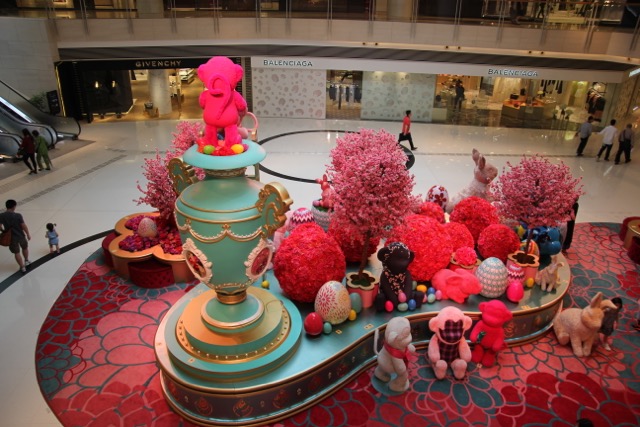
One of the cavernous, marbleous malls - this one in Kowloon - one of many
My son took me for lunch at the prestigious China Club, formerly the Bank of China, a lovely old colonial building in the heart of Central, now a haven of solitude. Rosewood and dark timbers, white jacketed Raj-like waiters, chopstick etiquette (the black ended ones for bringing communal food to your plate, silver ended ones for personal consumption - lesson learned!). We had a quiet area as befits lunch with a deafie (me), but in the dining room, the eating, and bleating, were in full meeting. Chairman Mao next to a signed Whitney Houston poster, one of many artworks beside the stairway.

Green space amid the towers. From the China Club balcony

The Chairman and Whitney on the wall at the China Club
Plenty of colonial era buildings as well, that "pop, peek-a-boo," out from behind taller siblings, more granite and columns, than windows and steel. The Ministry of Final Justice a stand out, set in a wonderful park environment with old fashioned statue of Governor long gone, as well as contemporary sculptures, including the Wandering Man who is sited in a few locations, gazing out from sculpted eyes, supposedly envisaging the future. There is a Cenotaph, just like the one in Whitehall. The Chinese flag flies atop a few buildings, but even the Communist Party Headquarters is rather demure. Under the "One Country, Two Systems" some protest, is tolerated. Except when the politics becomes demonstrative, such as protests about the Beijing appointed Chief Executive, of the Legislative Council, and "his lack of gumption," then Beijing's velvet glove often comes off.
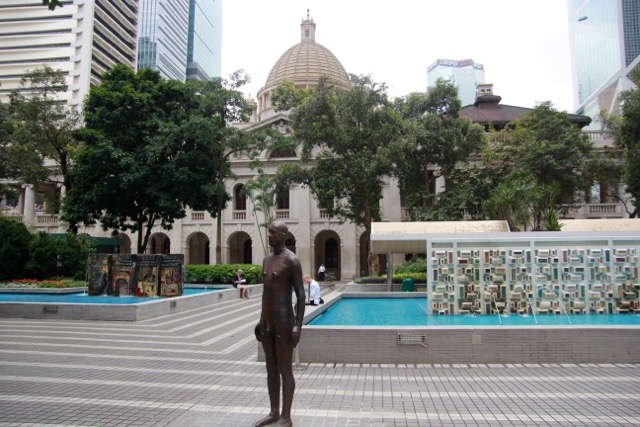
The Wandering Man and background, Final Court of Justice
Almost juxtaposed nearby, is the Norman Foster designed (think Heathrow's Terminal 5!) Hong Kong Shanghai Bank edifice, of 52 floors, with its incredible atrium and its Trafalgar Square-like Lion statues on guard outside. Many superstitious passersby pat the paw of one to wish for good health, something to which I rapidly acceded. At the cost of $US1 billion when completed in 1985, the building was largely built in sections in the UK, and shipped to Hong Kong for assembly and outfitting. Some allege that it was built that way so that it could also be disassembled in case there was ever a requirement to "leave Hong Kong following the handover in 1997." The building is at 1 Queen's Road, an irony lost on most!
There are plenty of temples, like the Man Mo, with what I thought were crayfish pots hanging from the ceiling, which turned out to be giant incense coils. The sweet scent of candle wax and incense is always pervasive in temples, in that not unpleasant manner of perfume or after-shave in the elevator. Temples are everywhere, in homage to Buddha, or as in Stanley, to a fortunate Saint in whose Temple partitioners sheltered in1942 and while two bombs came through the roof, they did not explode.
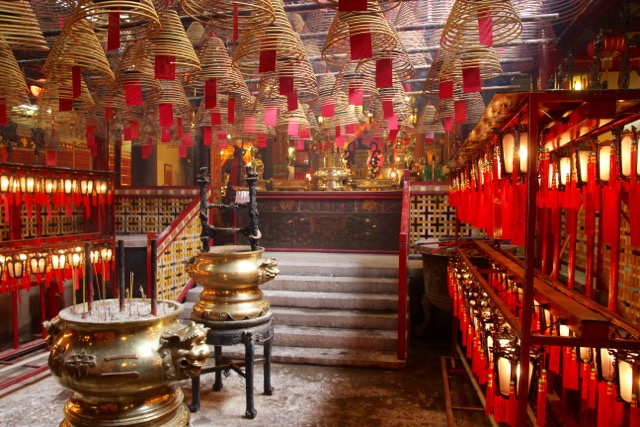
The Man Mo Temple with the incense roof coils and the aroma of wax candles.
My visit to Hong Kong coincided with the advent of the world famous Hong Kong Sevens rugby tournament, and the city was at its effervescent best. Well, except for the weather - there was rain and the almost incessant fog during my time there. It obscured much of the famed view from the Peak, although the famous cog railway ride to the top was probably worth the not inconsiderable cost, if only for the experience. After heavy rain abated, my son drove me to the top, and although almost twilight, the view was superb.

View from the Peak pathway at dusk, after the rain had stopped

Looking further along the Harbour and Kowloon, towards Kai Tak
On a day that the rain clattered only briefly, I visited the tranquil Walled City of Kowloon. Once a water’s edge fort important to the Chinese Qing Government following the British occupation of Hong Kong island, it was taken over by the British in 1899, and the Qing expelled. Squatters occupied the dwellings within the walls; it became a squatter’s slum. From 1941 to 45 it was Japanese controlled, and they took parts of the stone walls to extend Kai Tak airport. After the War, the Walled city became a "hotbed of vice," controlled by Triad gangs overseeing prostitution, brothels, and drug dens. It was bulldozed in 1987 by the soon to be departing British authorities and with Chinese agreement some walls left standing. In 1995, it opened as a citizen’s park. Lovely it is too, with tree lined walks, manicured gardens, a pond with a golden pagoda (and tortoises) and a sizeable area set aside for kids activities, including a decent mini cycle track.
A short taxi drive away, there was the the magnificent Chi Lin Buddhist nunnery, and across a busy road, the traditional contemplative garden. The site on Diamond Hill was actually constructed in 1934, in the style of the Tang Dynasty, but was largely rebuilt in the 1990s. The nunnery pays homage to Buddha Sakyamum, the God of Mercy, and he and his two helpers look out on a courtyard of a hundred Bonsai trees and lion sculptures spouting a steady stream into ponds full of pink and blue lotus flowers. It remains the world's largest wooden structure to be completely built without nails. All the sweet smelling cypress pine is fitted together with tongue and groove joints, and even the worst typhoons have not done any structural damage. Again, in the middle of surrounding Kowloon, it is a place of sublime restfulness where you float as in a bubble.

The Buddhist Nunnery with its ponds and Bonsai trees

The Golden Pagoda in the restful gardens of the Nunnery

Lily ponds, Lotus flowers, and spouting lions at the Nunnery
Kowloon, too, has the iconic Peninsula Hotel, which, like the Raffles in Singapore, maintains a colonial tuxedo-like decor, with its colonnaded dining room and grand entrance, a high tea still very twee, for you and me. It serves those cucumber sandwiches designed by Pythagoras, that fine China tea service which makes you extend that little pinkie on holding the cup to show you belong...even if you didn't arrive by one of the three Rollers outside the door or not come from Prada, next door.

The entrance to the Peninsula Hotel, Kowloon
The other wonderful edifice is the former Marine Police headquarters, a late C19th Building of Victorian splendour, when the waters lapped near the front doors and there were stables out the back for the police horses. Now apparently, the building is given over to shops to impress the bevy of visitors, and called 1881, belying the fact that the building dates from 1884. It is always interesting to look at your hotel lift panel and see if there is a 4th floor, the number associated with bad luck and death by many superstitious Chinese. If history doesn't please you, just change the history and get rid of those 4's!
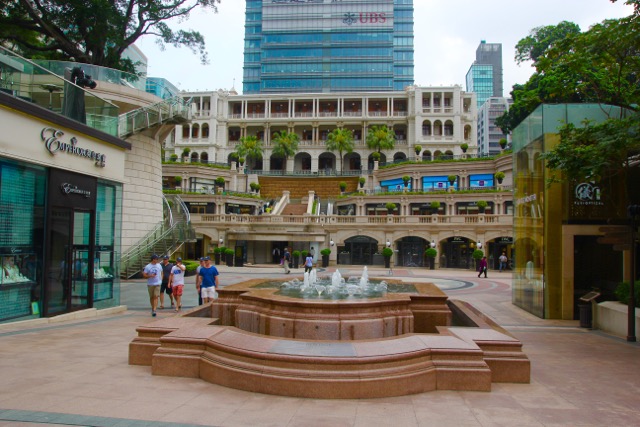
The Old Marine Police Headquarters, Kowloon
The trouble with the Star ferry: it is simply not a long enough journey. The return journey is covered by $HK2, and you are hard pressed to find peanuts that cheap. So we took the First ferry for an hour across the water to the island of Chueng Chau on a day when that cad, Philius, had taken to ground the Fogg in more than 80 ways…even cancelling a trip to Macau.

The Star Ferry - $2HK gets you a return journey; Previously also a 3rd class ticket!
CC was, in the main, a fishing village with an almost Greek islands feel and attractions. Only one or two official cars, a golf cart for police, an ambulance too, a temple on a mount, and a thriving beach, spotless in the summer, deserted this day. Plenty of attractive houses, (there is a fast ferry to HK island), traditional markets aplenty, but a bloody "Golden Arches" at the ferry wharf, to sort of spoil the setting. We enjoyed the brief stay and a trip through the inshore waters, through a freighter armada that must have resembled the D-Day invasion fleet. All heading to parts of Victoria Harbour, the 3rd largest freight harbour in the world. Macau, will have to wait for next time.
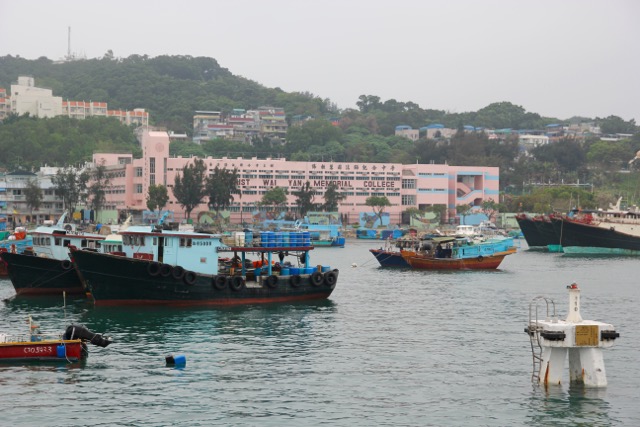
Fishing harbour Chueng Chau
I left Honkers, yearning to return. There is much of the surface to scratch. People friendly and helpful, but don't expect them to hold the door open for you to follow them through. A numbers thing I imagine, they'd be there forever! Took the fast train to the airport, after my bag and I were checked in. See you in Sydney, bag. And so it came to pass. Smart systems, efficient processes. Things that we Down Under just wonder ... then form a committee, demand a report, seek a review, think about it ... as years, and tears, go by!
Winfred Peppinck is the Tales of the Traveling Editor for Wandering Educators. He's got a new book out, entitled The Dogs Who Were Left Behind - read our author interview!
All photos courtesy and copyright Winfred Peppinck
